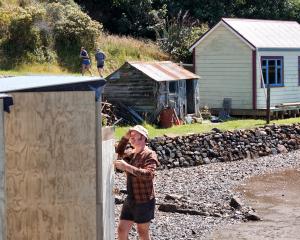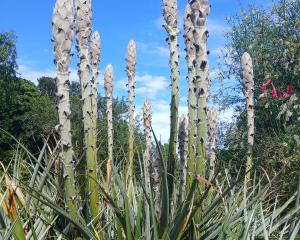Shelter and water conservation techniques have made all the difference to an Otago Peninsula garden, reports Gillian Vine.
Relying on tank water means farm gardens can suffer in a dry summer like this one.
Sharron Morris employs two main strategies in her Sandymount garden.
To offset the drying effects of the wind and to avoid unnecessary watering (they are on tank water), ''I plant everything close together ... and if there are gaps, I mulch, mulch, mulch.''
In addition, she and her husband, Bob, have made informed plant choices, growing those that are happy in their challenging situations.
Grey-leafed plants are often recommended for dry gardens, especially in coastal areas, and those in the Morris garden, including healthy succulents and honeywort, demonstrate how well this works.
Leathery leaves also withstand salt-laden air, so Chilean lantern tree (Crinodendron hookerianum) and container-grown Californian lilac (Ceanothus), as well as pohutukawa, olearia and pittosporum do well here.
Thirty years ago, Sharron and Bob moved house on their Sandymount farm.
The views along the coast in each direction were stunning but the drawback was the wind.
''We're exposed to every wind that comes,'' Sharron says.
The northeasterlies are the worst because they dry out the soil to the greatest extent.
When they moved in, the house was so exposed that if there was a storm, Bob would park the tractor in the drive to deflect the wind that otherwise threw stones against the house.
After living in a nearby valley, they found the strong, salt-laden winds on the hill a shock and one that made gardening difficult.
''We tried all manner of things but [nothing worked] until we got the shelter in,'' Bob says.
Sharron adds: ''We certainly learned by experience.''
The original farm - significantly smaller than the present property - was developed by Bob Morris' great-great-grandfather.
He settled on Otago Peninsula in 1858, initially at Highcliff, where he grew vegetables for sale to miners.
He then moved to Sandymount, building a house in the valley that has, Sharron says, a great microclimate.
A rose, possibly Félicité Perpétue, planted by the old house, still thrives more than 140 years on.
''It's stood up to sheep and it's never been fertilised,'' Bob says. It gets no water unless it rains.
When they moved to the new house, the Morrises planted pines for shelter, as well as hedges of native olearia and pittosporum.
''We regret now that we put in pine trees, not natives,'' Sharron says.
A large pohutukawa, one of the first decorative trees they grew, was planted in ''the coldest, most exposed place'' where, to their surprise, it flourished, as does a variegated form.
A line of them, rather than pines, would be Sharron's choice if she was starting out now.
''I wish I'd grown hundreds. They bring in the birds, too.''
The garden was not done in one hit, but tackled in small pieces, making it easier to manage, a technique that other gardeners could copy for new or neglected areas.
Sharron loves New Zealand brooms and has a collection that includes two of the smallest.
Not often seen, they make neat little cushions, perfect for the rockery.
She has a splendid weeping broom (Carmichaelia stevensonii), a compact 1.5m tree which has purplish flowers on its leafless branches.
When not in flower in summer, most native brooms look like the weedy Scotch broom (Cytisus scoparius), but C. williamsii has flat stems and in spring produces lemon flowers with purple veins.
They are bigger than the mauve or white flowers of the other native species the Morrises grow.
Most of these brooms are now rare in the wild and good for gardens that tend to dry out in summer.
There are lots of other natives in the Morris garden: lilac-flowered Heliohebe hulkeana, scarlet kaka beak, Chatham Island forget-me-not, native geraniums and a splendid Poor Knights lily (Xeronema callistemon) in a pot.
Natives are mixed with introduced plants to great effect.
For example, ferns intermingle with hostas in a cool-looking green area and a karo hedge protects an old Rhododendron fragrantissimum, moved from the garden of Sharron's mother when she down-sized.
The Morris garden looks impressive and shows how much clever gardeners can achieve without resorting to constant watering.











